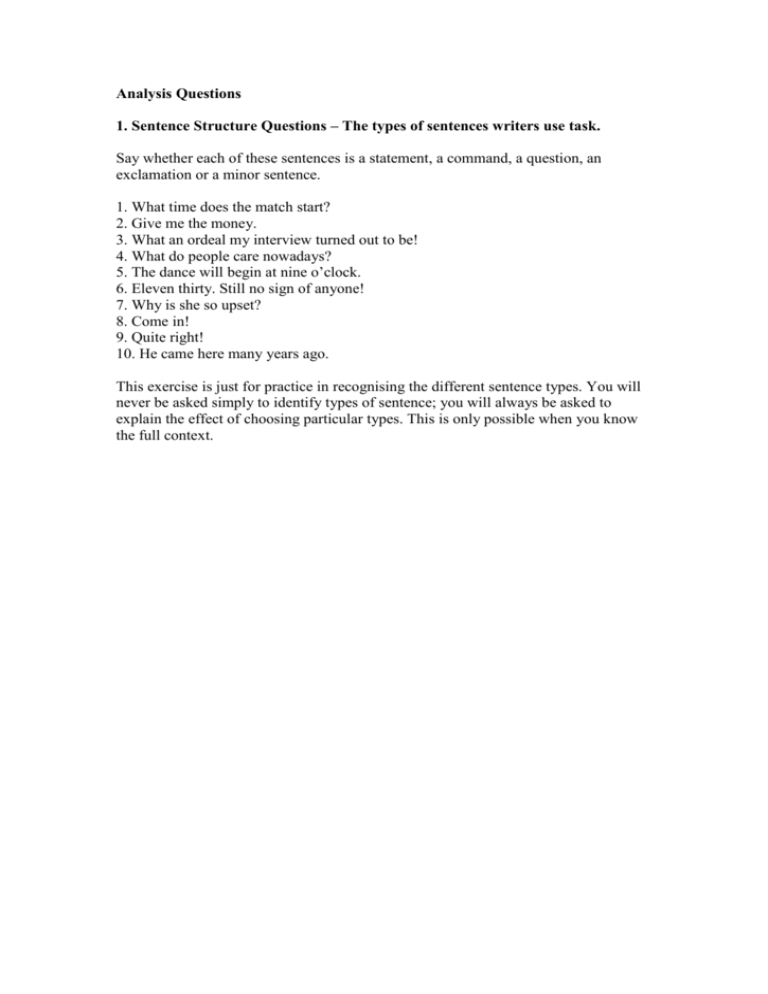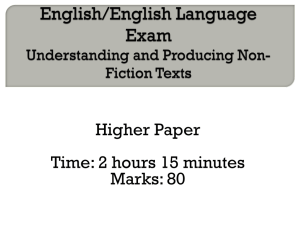1 Sentence Structure Tasks
advertisement

Analysis Questions 1. Sentence Structure Questions – The types of sentences writers use task. Say whether each of these sentences is a statement, a command, a question, an exclamation or a minor sentence. 1. What time does the match start? 2. Give me the money. 3. What an ordeal my interview turned out to be! 4. What do people care nowadays? 5. The dance will begin at nine o’clock. 6. Eleven thirty. Still no sign of anyone! 7. Why is she so upset? 8. Come in! 9. Quite right! 10. He came here many years ago. This exercise is just for practice in recognising the different sentence types. You will never be asked simply to identify types of sentence; you will always be asked to explain the effect of choosing particular types. This is only possible when you know the full context. Analysis Questions 1. Sentence Structure Questions – Parenthesis Task For Practice Read this article on the artist Vincent van Gogh. Pick out two examples of parenthesis and explain what each adds to the text. Think of poor old Vincent and you think of. . . Kirk Douglas1? Philistine2! You could talk about Vince at breakfast, dinner and tea for months, so let’s begin by scotching that old chestnut about his right ear. He didn’t cut it off, OK? Only the lobe. Meet Vincent van Gogh (1853—90), the eldest of six children. He’s stubborn and volatile3, doesn’t get on with his Dutch pastor father, or his mother, and leaves home as soon as possible. His brother Theo tries to find him a job. Alas. One hard-luck story leads to another. Awkward young Vincent is unemployable as a picture dealer, and as a teacher, and he hits the pits (sorry) as a lay preacher in the Belgian coal-fields. Aged 27, he decides to become an artist and (at Antwerp Academy) proves to be unteachable too. He learns what he can, when he can, by bumming around. To judge by some of his terrific drawings up to 1885, he learns a lot. Then, in 1886, he arrives on Theo’s doorstep in Paris. Theo has a family, but adds Vincent’s money worries to his own. Vincent’s painting style changes completely. Before Paris, it’s a kind of atmospheric sludge. Once there, bright, vibrant colours are soon in evidence, in a style influenced by a new love, Japanese prints. But Vincent’s drinking and bad temper haven’t lessened, and in 1888 Theo’s relieved when Big Brother moves down south, to ArIes. 1Kirk Douglas: actor who played van Gogh in a Hollywood film. 2Philistine: a person who knows nothing about art or culture. 3Volatile: moody. Analysis Questions 1. Sentence Structure Questions – Punctuation Task For Practice The following examples all focus on sentence structure and / or punctuation. The number of marks indicates how much you should write for each answer. 1. (The narrator in this extract is a young boy who has lost his horse, Rob Roy.) It would take me years to live down the disgrace. In the meantime I must hurry home as fast as my dismounted legs could carry me. If only I could catch sight of that wretched Rob Roy eating some more grass by the roadside! If only I hadn’t let him go! If only I could begin my ride all over again! How careful I would be! Question: Show how the author uses sentence structure to emphasise the narrator’s sense of shame and panic at losing his horse. (2 marks) 2. Scrooge became as good a friend, as good a master, and as good a man as the good old City knew. Question: How does Dickens use sentence structure to emphasise the dramatic way in which his character, Scrooge, has reformed? (2 marks) 3. We went on the ghost train; we went on the chairoplanes and we went on the waltzers; we went on the giant roller coaster; we even — plucking up our courage! — went on the rocket launcher that actually turned upside down; finally, heads spinning and stomachs heaving, we tottered down to the low wall at the sea front for a welcome gulp of fresh air. Question: Show how the writer uses two features of sentence structure to emphasise the number of fairground rides the children went on, and how these get more and more daring. (2 marks) 4. Of all bad deeds that, under cover of the darkness, had been committed within wide London’s bounds since night hung over it, that was the worst. Of all the horrors that rose with an ill scent upon the morning air, that was the foulest and most cruel. Question: This comment is made about Bill Sykes’s murder of Nancy in Dickens’s ‘Oliver Twist’. How does Dickens use sentence structure to emphasise the dramatic nature of the deed? (2 marks) 5. Here was room for the imagination to work! You could imagine those lights the width of a continent away — and that hidden under the intervening darkness were hills, and winding rivers, and weary wastes of plain and desert — and even then the tremendous vista stretched on, and on, and on! — to the fires and far beyond! Question: Show how the writer uses sentence structure to emphasise the huge extent of the crater of this giant volcano. (Look for sentence types, use of conjunctions and repetition. Use the punctuation as a clue.) (5 marks) 6. “Er, excuse me. Excuse me. Excuse me, do you mind? Excuse me would you mind keeping it down just a little? Excu . . . look, are you just gonna SHUT UP !!??!!“ About nine times out of ten, this is exactly the sort of thing you never say to the person behind you in the cinema. Question: Show how the writer uses sentence structure and punctuation to create a convincing picture of someone in a cinema plucking up the courage to complain to someone who is disturbing him by talking. (5 marks) 7. You couldn’t see far and you couldn’t see plain, but there was the deep sea moving on its way about the night earth, flat and quiet, the colour of grey mud, and here were the two of us alone in the high tower, and there, far out at first, was a ripple, followed by a wave, a rising, a bubble, a bit of froth. And then, from the surface of the cold sea came a head, a large head, dark-coloured, with immense eyes, and then a neck. And then — not a body — but more neck and more! Only then did the body, like a little island of black coral and shells and crayfish, drip up from the subterranean. Question: How does the writer use sentence structure to emphasise the immense size of the sea monster? (4 marks) 8. I well remember though, how the distant idea of the holidays, after seeming for an immense time to be a stationary speck, began to come towards us, and to grow and grow. How, from counting months, we came to weeks, and then to days; and how I then began to be afraid that I should not be sent for and, when I learnt from Steerforth that I had been sent for and was certainly to go home, had dim forebodings that I might break my leg first. How the breaking-up day changed its place fast, at last, from the week after next to next week, this week, the day after tomorrow, tomorrow, today, tonight — when I was inside the Yarmouth mail-coach, and going home. Question: Show how the writer uses sentence structure to show how time appears distorted to a small boy at boarding school who is desperate for the holidays to arrive. (4 marks) 9. At unequal distances all around the shores of the lake were nearly white- hot chimneys or hollow drums of lava, four or five feet high, and up through them were bursting gorgeous sprays of lava gouts and gem spangles, some white, some red and some golden — a ceaseless bombardment, and one that fascinated the eye with its unapproachable splendour. Question: Show how the author uses sentence structure to create a sense of drama in this description of a volcano erupting. (Points to note: the length of the sentence; the use of in version in lines 2—3; the effects of repetition of certain phrases; and the relationship of the part of the sentence after the dash to the first part of description.) (5 marks) 10. Boidwood had turned quickly, taken one of the guns and at once fired it at Troy. Troy fell. The distance apart of the two men was so small that the charge of shot did not spread in the least, but passed like a bullet into his body. He uttered a long guttural sigh — there was a contraction — an extension — then his muscles relaxed, and he lay still. Question: Show how the author’s sentence structure indicates the suddenness of the shooting and also presents the last moments of the victim realistically. (4 marks)







